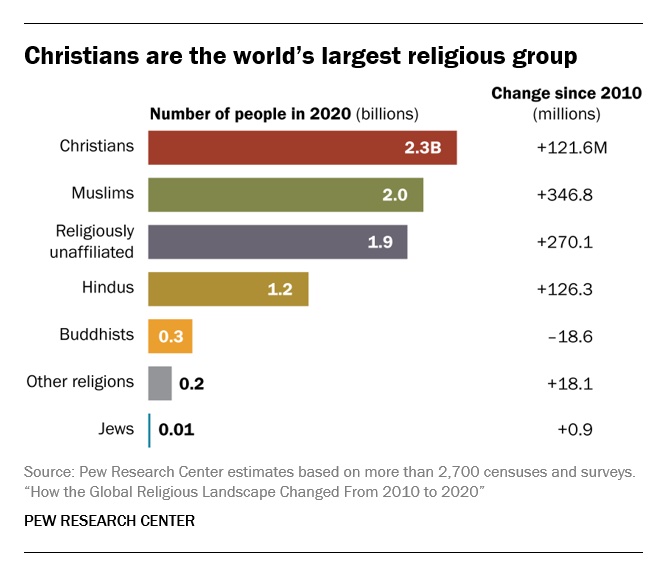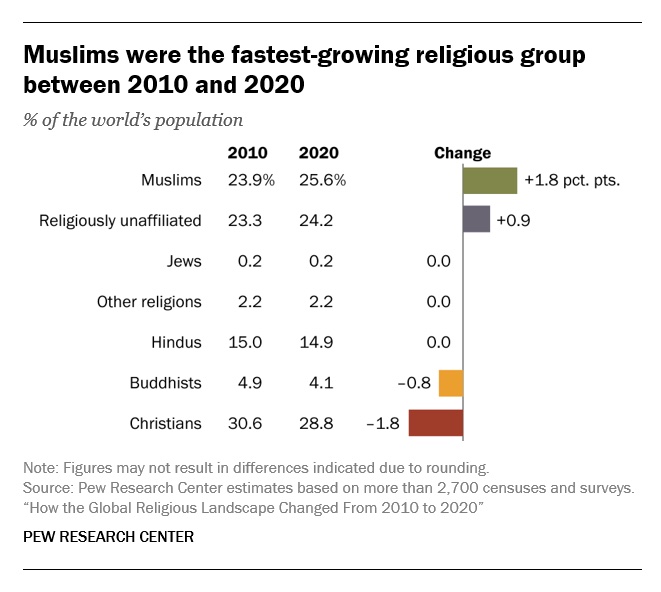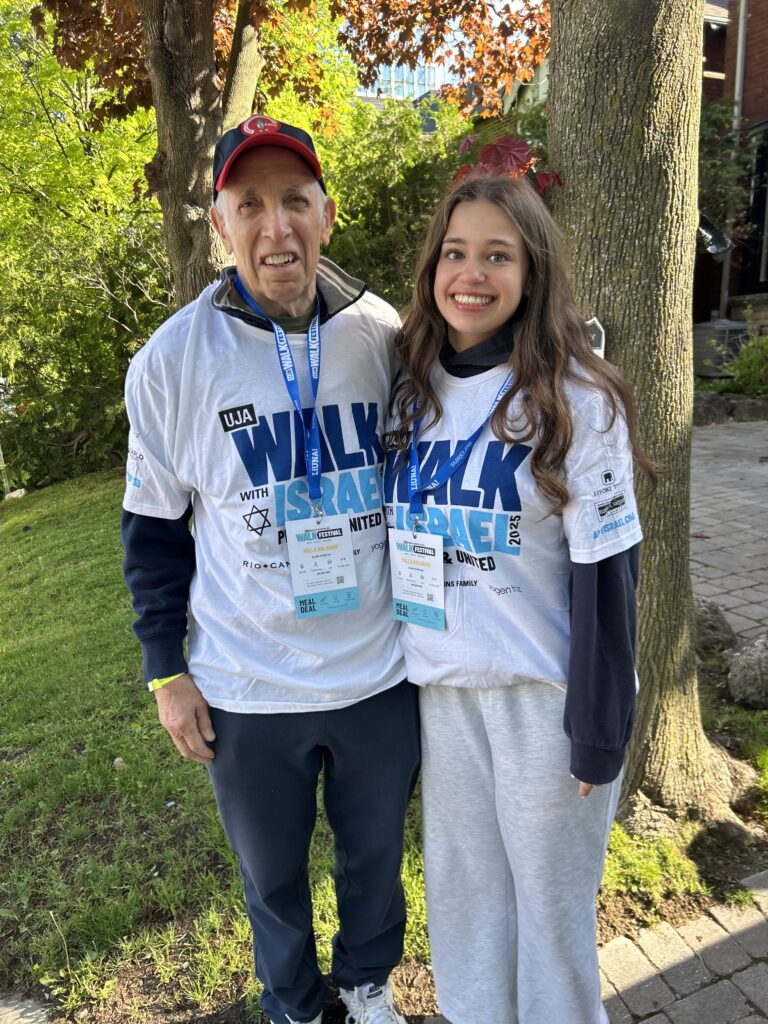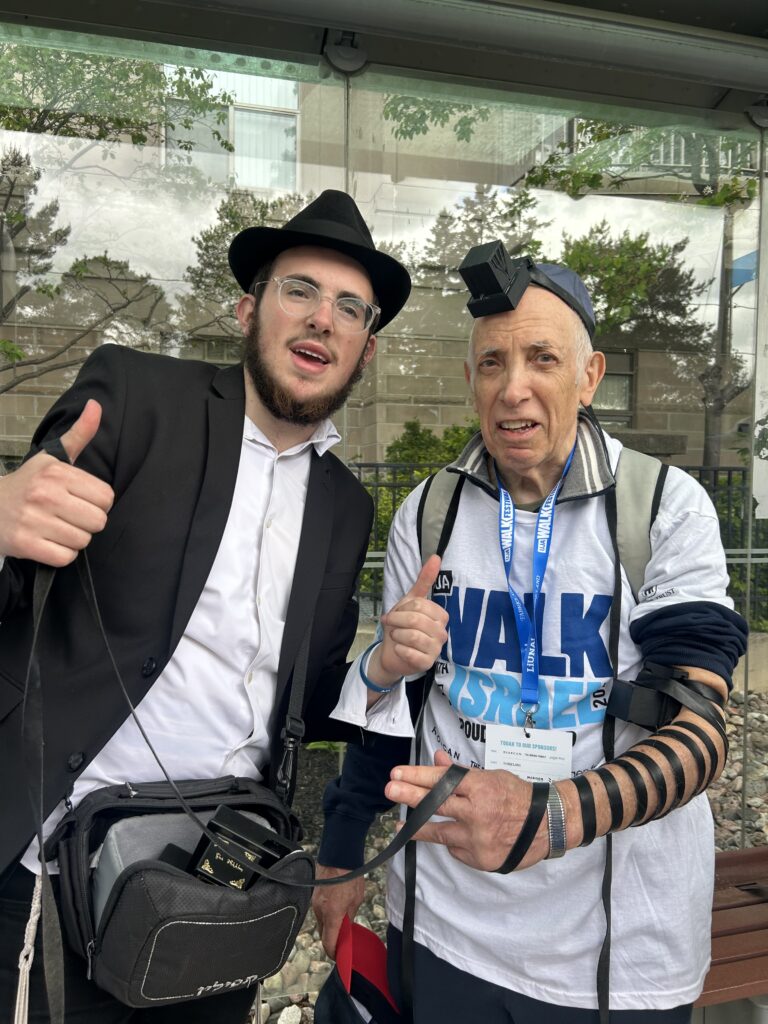Uncategorized
How the CEO of New York’s largest food bank is inspired by Jewish values
(New York Jewish Week) — At the Food Bank for New York City, one of the largest food banks in the country, the holiday season is crucial to ensuring New Yorkers have enough food to be able to live with dignity.
Since its founding in 1983, the organization has provided over one billion meals to New Yorkers in need — as well as offering free SNAP assistance, tax preparation services and financial literacy programs to low-income residents.
“Our central mission is that we feed people for today, but we have made significant investments in programming that truly helps to lift people out of poverty,” president and chief executive officer Leslie Gordon told the New York Jewish Week. “Because the reason why people are food insecure to begin with is a resource problem. It’s an inability to get connected to networks or resources, because of racist systems or policy issues.”
Gordon, who is Jewish, has helmed the organization since 2020, and in some ways, rose to the role in a way that seemed inevitable. As a child, she loved to watch her grandfather sell meat, produce and other goods from the grocery store he owned in Tarrytown, New York, and deliver food donations to the needy. Her mother, who also grew up at the store, was the executive director at the Hunts Point Produce Market, the country’s largest wholesale produce market.
Prior to joining Food Bank for New York, Gordon held leadership roles at Feeding Westchester, a food bank network in Westchester County and City Harvest, which helps make fresh, nutritious food accessible around New York. Starting her job at the beginning of the pandemic, Gordon has overseen a doubling of the Food Bank for New York’s annual food distribution across the city from 70 million pounds to 150 million pounds.
A fourth-generation Tarrytown resident, Gordon has been a member of the Conservative congregation Temple Beth Abraham her entire life. She lives in the same house that she, her grandfather and her mother grew up in, with her wife, two dogs and two cats.
The New York Jewish Week chatted with Gordon about her background, her favorite parts of the job and the Jewish family values that got her here.
This interview has been lightly condensed and edited for length and clarity.
After leadership roles at two other food banks, Gordon took over the top position at Food Bank for New York City in March 2020. She credits her Jewish family values for helping guide her. (Courtesy)
New York Jewish Week: How have your Jewish values guided you as the CEO of Food Bank for New York?
Leslie Gordon: The thing about my connection to Judaism at the Food Bank is really a personal responsibility around doing tikkun olam. It’s an ever-present, everyday commitment to making the world more just and equal through social action, which is what we do every day at Food Bank — helping New Yorkers across the five boroughs to have the resources they need to be able to have a stable, healthy life where they can thrive and look forward to working on achieving their dreams.
Food is culture. Food is love. Food is history. Food has always been a big part of my personal Jewish experience — whether through holidays or through historical explorations. My grandfather was a butcher. He grew up in a small Jewish enclave in Rockland County called Pot Cheese Hollow [now Spring Valley], which is a sort of a European framing for all things cottage cheese.
You started this job right at the beginning of the pandemic. What was that like, and what was the path that led you to working at Food Bank?
I’ll never forget this: My first day was March 30, 2020. It was a little crazy to be the humble leader of one of the nation’s largest food banks at a time when the need was historically outsized and quickly escalated. It was a little bit of a challenge and, frankly, has been for most of my tenure.
Again, it goes back to my Jewish familial roots. I am carrying on a family legacy of feeding people: My grandfather, Norman Goldberg, was the son of European immigrants. When they came over [to America], and in his growing up years in that enclave in Rockland County, they were really, really poor. One of their biggest assets, believe it or not, was a dairy cow — no running water, no indoor plumbing. He would tell stories as kids that sometimes the only thing he ate in the course of a day was an apple that he picked off a neighboring farmer’s tree.
Fast forward many years into the future, he was a successful businessman, between a grocery store, a butcher store and a wine and liquor store, amongst other pursuits. He never forgot where he came from and he would talk to us about the importance of connecting people with food, and again doing tikkun olam. They would get phone calls from the rabbi at Temple Beth Abraham in Tarrytown, where they lived, because food banks and food pantries didn’t exist back then — the World War II era all the way through the 1950s, ’60s, and even ’70s. They would get a list of people in the community who needed help and [my grandfather] would take my mother by the arm and they would go to the local grocery store and shop. Frequently, as my mom tells it now, they’d end up in a local fourth-floor walk-up apartment building, ring the bell, drop the groceries and go, because you wanted to preserve the dignity of those whom you are helping.
That really made an impression on me. My grandfather was also an avid backyard gardener and was famous for leaving those little brown lunch bags full of excess produce from his backyard garden on people’s stoops.
My mother became the head of the world’s largest wholesale produce terminal, which is based in the Hunts Point section of South Bronx. I caught the bug on logistics and operations in food and really the romanticism of the food system. I’m still of that generation where I feel very connected to my local food system and farmers. I had a very unique growing up experience, where I got to see train cars full of broccoli or potatoes or other amazing produce that traveled through small towns and cities across the United States to land up in the South Bronx. So, I’ve been in the arena of food banking for about 15 years. I couldn’t have predicted it, I call it a happy accident. Of the 10 food banks in New York State, I’ve had the pleasure and honor of leading three of them.
What type of outreach do you do to New York’s Jewish community?
We’re a city of about 8.4 million people, and 1.6 million of them, give or take, are people who just don’t know where their next meal is coming from or what it will be. Ask yourself: Have you ever been hungry for a long period of time during the day? How do you deal with that? Imagine if that was your every day. That is compounded, potentially, by other struggles that you have. People don’t live single-issue lives. So, typically, when you’re food insecure, there are a lot of other issues that you’re grappling with — could be housing issues, could be mental health issues, could be employment or underemployment issues. There’s just a lot going on in the mix. New York City is a particularly expensive place to live. It’s a tough environment.
We’re the heart of a network of about 800 on-the-ground partners across the five boroughs. On nearly every street in nearly every neighborhood, our partners are food pantries, community kitchens, senior centers, shelters, community-based organizations like New York City Housing Authority or a Boys and Girls Club. In the case of the Jewish community, we have relationships with more than 40 on-the-ground agencies that specifically serve observant Jews. Organizations like Masbia, Alexander Rapoport’s restaurant-style soup kitchen that he’s now famous for.
We’re serving one of the nation’s largest kosher observant populations in the U.S. right here in New York City. We’re committed to making sure that kosher-observing communities in Williamsburg, Midwood, Crown Heights, Coney Island, Lower East Side, etc., have access to good kosher food that they can feel good about. The number of Jews in New York City who struggle is just astounding. We have a very large Jewish population, obviously. And so, you know, it’s something that’s on my mind a lot. I’ve had the opportunity to work with the Jewish community in New York now for over 15 years. Studies tell us that more than 10% of Jewish adults, and Jewish adults with kids in New York are food insecure. It’s serious. You’d be astounded, probably, to learn that more than 20% of adults in Jewish households in New York are at the poverty line.
What is your favorite part of the job?
A job as a food bank leader is very, very unique. In the course of a day, I can work on operations, I can work on marketing and communications, I can meet with donors, I can be on the phone with one of our agencies or food pantries on the ground, or I can be working on policy or advocacy. So it’s a really varied position. The most fun part about my job is the people and the stories. It’s the people who we serve who just have really big hearts and deep and interesting personal stories, and they’re just like you and me — moms and dads and families and kids who are trying to live their best life. We take the opportunity to be able to help them along the way pretty seriously.
For me, it starts internally with our Food Bank family. I take that really seriously. The culture in the organization is really important to me. I want people to feel supported and have all the resources they need to do their job, to be excited and energized about the ability and opportunity they have to impact people’s lives. At the end of the day, it’s always the people.
I’m a bit of a builder, and a fixer. It’s just who I am. Why I’m that way, I have no idea. My mother tells me that I’m my grandfather’s granddaughter. I just have a particular affinity for how things work and systems and processes and making things better and more efficient. It’s just part of my DNA, I guess. That is a skill set that really fits well with what’s required to run a food bank.
—
The post How the CEO of New York’s largest food bank is inspired by Jewish values appeared first on Jewish Telegraphic Agency.
Uncategorized
How the Global Religious Landscape Changed from 2010 to 2020

Muslims grew fastest; Christians lagged behind global population increase
• Christians are the world’s largest religious group, at 28.8% of the global population. They are a majority everywhere except the Asia-Pacific and Middle East-North Africa regions. Sub-Saharan Africa has surpassed Europe in having the largest number of Christians. But Christians are shrinking as a share of the global population, as millions of Christians “switch” out of religion to become religiously unaffiliated.

• Muslims are the world’s second-largest religious group (25.6% of the world’s population) and the fastest-growing major religion, largely due to Muslims’ relatively young age structure and high fertility rate. They make up the vast majority of the population in the Middle East-North Africa region. In all other regions, Muslims are a religious minority, including in the Asia-Pacific region (which is home to the greatest number of Muslims).

• The religiously unaffiliated population is the world’s third-largest religious category (24.2% of the global population), after Christians and Muslims. Between 2010 and 2020, religiously unaffiliated people grew more than any group except Muslims, despite their demographic disadvantages of an older age structure and relatively low fertility. The unaffiliated made up a majority of the population in 10 countries and territories in 2020, up from seven a decade earlier.
• Hindus are the fourth-largest religious category (14.9% of the world’s population), after Christians, Muslims and religiously unaffiliated people. Most (99%) live in the Asia-Pacific region; 95% of all Hindus live in India alone. Between 2010 and 2020, Hindus remained a stable share of the world’s population because their fertility resembles the global average, and surveys indicate that switching out of or into Hinduism is rare.
• Buddhists (4.1% of the world’s population) are the only group in this report whose number declined worldwide between 2010 and 2020. This was due both to religious disaffiliation among Buddhists in East Asia and to a relatively low birth rate among Buddhists, who tend to live in countries with older populations. Most of the world’s Buddhists (98%) reside in the Asia-Pacific region, the birthplace of Buddhism.
• Jews, the smallest religious group analyzed separately in this report (0.2% of the world’s population), lagged behind global population growth between 2010 and 2020 – despite having fertility rates on par with the global average – due to their older age structure. Most Jews live either in North America (primarily in the United States) or in the Middle East-North Africa region (almost exclusively in Israel).
These are among the key findings of a Pew Research Center analysis of more than 2,700 censuses and surveys, including census data releases that were delayed due to the coronavirus pandemic. This report is part of the Pew-Templeton Global Religious Futures project, which analyzes global religious change and its impact on societies around the world. Funding for the Global Religious Futures project comes from The Pew Charitable Trusts and the John Templeton Foundation.
Uncategorized
Antisemitism in some unlikely places in America

By HENRY SREBRNIK Antisemitism flourishes in a place where few might expect to confront it – medical schools and among doctors. It affects Jews, I think, more emotionally than Judeophobia in other fields.
Medicine has long been a Jewish profession with a history going back centuries. We all know the jokes about “my son – now also my daughter – the doctor.” Physicians take the Hippocratic Oath to heal the sick, regardless of their ethnicity or religion. When we are ill doctors often become the people who save us from debilitating illness and even death. So this is all the more shocking.
Yes, in earlier periods there were medical schools with quotas and hospitals who refused or limited the number of Jews they allowed to be affiliated with them. It’s why we built Jewish hospitals and practices. And of course, we all shudder at the history of Nazi doctors and euthanasia in Germany and in the concentration camps of Europe. But all this – so we thought – was a thing of a dark past. Yet now it has made a comeback, along with many other horrors we assume might never reappear.
Since the Hamas attack on Israel on October 7, 2023, there has been a resurgence of antisemitism, also noticeable in the world of healthcare. This is not just a Canadian issue. Two articles on the Jewish website Tablet, published Nov. 21, 2023, and May 18, 2025, spoke to this problem in American medicine as well, referencing a study by Ian Kingsbury and Jay P. Greene of Do No Harm, a health care advocacy group, based on data amassed by the organization Stop Antisemitism. They identified a wave of open Jew-hatred by medical professionals, medical schools, and professional associations, often driven by foreign-trained doctors importing the Jew-hatred of their native countries, suggesting “that a field entrusted with healing is becoming a licensed purveyor of hatred.”
Activists from Doctors Against Genocide, American Palestinian Women’s Association, and CODEPINK held a demonstration calling for an immediate cease-fire in Gaza at the Hart Senate Office Building in Washington, D.C., Nov. 16, 2023, almost as soon as the war began. A doctor in Tampa took to social media to post a Palestinian flag with the caption “about time!!!” The medical director of a cancer centre in Dearborn, Michigan, posted on social media: “What a beautiful morning. What a beautiful day.” Even in New York, a physician commented on Instagram that “Zionist settlers” got “a taste of their own medicine.” A Boston-based dentist was filmed ripping down posters of Israeli victims and a professor at the University of Pennsylvania Perelman School of Medicine did the same. Almost three-quarters of American medical associations felt the need to speak out on the war in Ukraine but almost three-quarters had nothing to say about the war in Israel.
Antisemitism in academic medical centres is fostering noxious environments which deprive Jewish healthcare professionals of their civil right to work in spaces free from discrimination and hate, according to a study by the Data & Analytics Department of StandWithUs, an international, non-partisan education organization that supports Israel and fights antisemitism.
“Academia today is increasingly cultivating an environment which is hostile to Jews, as well as members of other religious and ethnic groups,” StandWithUs director of data and analytics, and study co-author, Alexandra Fishman, said on May 5 in a press release. “Academic institutions should be upholding the integrity of scholarship, prioritizing civil discourse, rather than allowing bias or personal agendas to guide academic culture.”
The study, “Antisemitism in American Healthcare: The Role of Workplace Environment,” included survey data showing that 62.8 per cent of Jewish healthcare professionals employed by campus-based medical centres reported experiencing antisemitism, a far higher rate than those working in private practice and community hospitals. Fueling the rise in hate, it added, were repeated failures of DEI (diversity, equity, and inclusion) initiatives to educate workers about antisemitism, increasing, the report said, the likelihood of antisemitic activity.
“When administrators and colleagues understand what antisemitism looks like, it clearly correlates with less antisemitism in the workplace,” co-author and Yeshiva University professor Dr. Charles Auerbach reported. “Recognition is a powerful tool — institutions that foster awareness create safer, more inclusive environments for everyone.”
Last December, the Data & Analytics Department also published a study which found that nearly 40 per cent of Jewish American health-care professionals have encountered antisemitism in the workplace, either as witnesses or victims. The study included a survey of 645 Jewish health workers, a substantial number of whom said they were subject to “social and professional isolation.” The problem left more than one quarter of the survey cohort, 26.4 per cent, “feeling unsafe or threatened.”
The official journal of the Alliance for Academic Internal Medicine concurs. According to “The Moral Imperative of Countering Antisemitism in US Medicine – A Way Forward,” by Hedy S. Wald and Steven Roth, published in the October 2024 issue of the American Journal of Medicine, increased antisemitism in the United States has created a hostile learning and practice environment in medical settings. This includes instances of antisemitic behaviour and the use of antisemitic symbols at medical school commencements.
Examples of its impact upon medicine include medical students’ social media postings claiming that Jews wield disproportionate power, antisemitic slogans at the University of California, Los Angeles (UCLA) David Geffen School of Medicine, antisemitic graffiti at the University of California, San Francisco (UCSF) Cancer Centre, Jewish medical students’ exposure to demonization of Israel diatribes and rationalizing terrorism; and faculty, including a professor of medicine at UCSF, posting antisemitic tropes and derogatory comments about Jewish health care professionals. Jewish medical students’ fears of retribution, should they speak out, have been reported. “Our recent unpublished survey of Jewish physicians and trainees demonstrated a twofold increase from 40% to 88% for those who experienced antisemitism prior to vs after October 7,” they stated.
In some schools, Jewish faculty are speaking out. In February, the Jewish Faculty Resilience Group at UCLA accused the institution in an open letter of “ignoring” antisemitism at the School of Medicine, charging that its indifference to the matter “continues to encourage more antisemitism.” It added that discrimination at the medical school has caused demonstrable harm to Jewish students and faculty. Student clubs, it said, are denied recognition for arbitrary reasons; Jewish faculty whose ethnic backgrounds were previously unknown are purged from the payrolls upon being identified as Jews; and anyone who refuses to participate in anti-Zionist events is “intimidated” and pressured.
Given these findings, many American physicians are worried not only as Jewish doctors and professionals, but for Jewish patients who are more than ever concerned with whom they’re meeting. Can we really conceive of a future where you’re not sure if “the doctor will hate you now?”
Henry Srebrnik is a professor of political science at the University of Prince Edward Island.
Uncategorized
The 2025 Toronto Walk (and talk ) for Israel

By GERRY POSNER There are walks and then there are walks. The Toronto UJA Walk for Israel on May 25, 2025 was one of a kind, at least as far as Canada and Jews are concerned. The number of people present was estimated to be 56,000 people or 112,000 total shoes. (How they get to that number is bewildering to me, since there is no one counting). This was 6,000 more than last year. Whether it is true or not, take it from me, it was packed. The synagogues in Canada should be so fortunate to get those numbers in total on High Holidays. The picture here gives you a sense of the size of the crowd.

This was my first walk in Toronto for Israel and I was with my granddaughter, Samantha Pyzer (not to forget her two friends whom she managed to meet at the site, no small feat, even with iPhones as aids). The official proceedings began at 9:00 a.m. and the walk at 10:00 a.m. There was entertainment to begin with, also along the way, and at the finish as well. The finish line this year was the Prosserman Centre or the JCC as it often called. The walk itself was perhaps 4 kilometres – not very long, but the walking was slow, especially at the beginning. There were lots of strollers, even baby carriages, though I did not see any wheelchairs. All ages participated on this walk. I figured, based on what I could see on the faces of people all around me that, although I was not the oldest one on the walk, I bet I made the top 100 – more likely the top 20.
What was a highlight for me was the number of Winnipeggers I met, both past and present. Connecting with them seemed to be much like a fluke. No doubt, I missed la lot of them, but I saw, in no particular order (I could not recall the order if my life depended on it): Alta Sigesmund, (who was, a long time ago, my daughter Amira’s teacher), Marni Samphir, Karla Berbrayer and her husband Dr. Allan Kraut and family. Then, when Samantha and I made it to the end and sat down to eat, I struck up a conversation with a woman unknown to me and as we chatted, she confirmed her former Winnipeg status as a sister-in- law to David Devere, as in Betty Shwemer, the sister of Cecile Devere. I also chanced upon Terri Cherniack, only because I paused for a moment and she spotted me. As we closed in near the finish, I met ( hey were on their way back), Earl and Suzanne Golden and son Matthew, as well as Daniel Glazerman. That stop caused me to lose my granddaughter and her pals. Try finding them amid the noise and size of the crowd – but I pulled it off.

As I was in line to get food, I started chatting with a guy in the vicinity of my age. I dropped the Winnipeg link and the floodgates opened with “ Did I know Jack and Joanie Rusen?” So that was an interesting few minutes. And I was not too terribly surprised to come across some of my Pickleball family. All of these meetings, along with spotting some of my sister’s family and other cousins, were carried on with the sound of the shofar as we moved along the way. In short, this was a happening. Merchants selling a variety of products, many of them Israeli based, were in evidence and, of course, the day could not have ended without the laying of tefillin, aided by Chabad, who have perfected the procedure to take less than a minute. See the photo. Chabad had a willing audience.
Aside from the joy of sharing this experience with my granddaughter, the very presence of all these Jews gathered together for a common reason made this day very special to me. However, there was a downside to the day. The downside was that, as we began to walk back to our car there was no other way I could figure out how to return when the rains came and came. While we walked faster, we were impeded by pouring rain and puddles. But Samantha wanted to persevere, as did I. We made it, but were drenched. My runners are still drying out as I write this two days later.
What with being surrounded by 56,000 people, the noise, the slow walking, and the rain, I can still say the day was a real highlight for me – one of the better moments since our arrival in Toronto in 2012. As well as the photos we took along the way, I have the reminder of the day, courtesy of the UJA, as evidenced from the photo. It was not just the walk, but the talk that accompanied the walk that made it so worthwhile for me. I would do it again, minus the rain.
